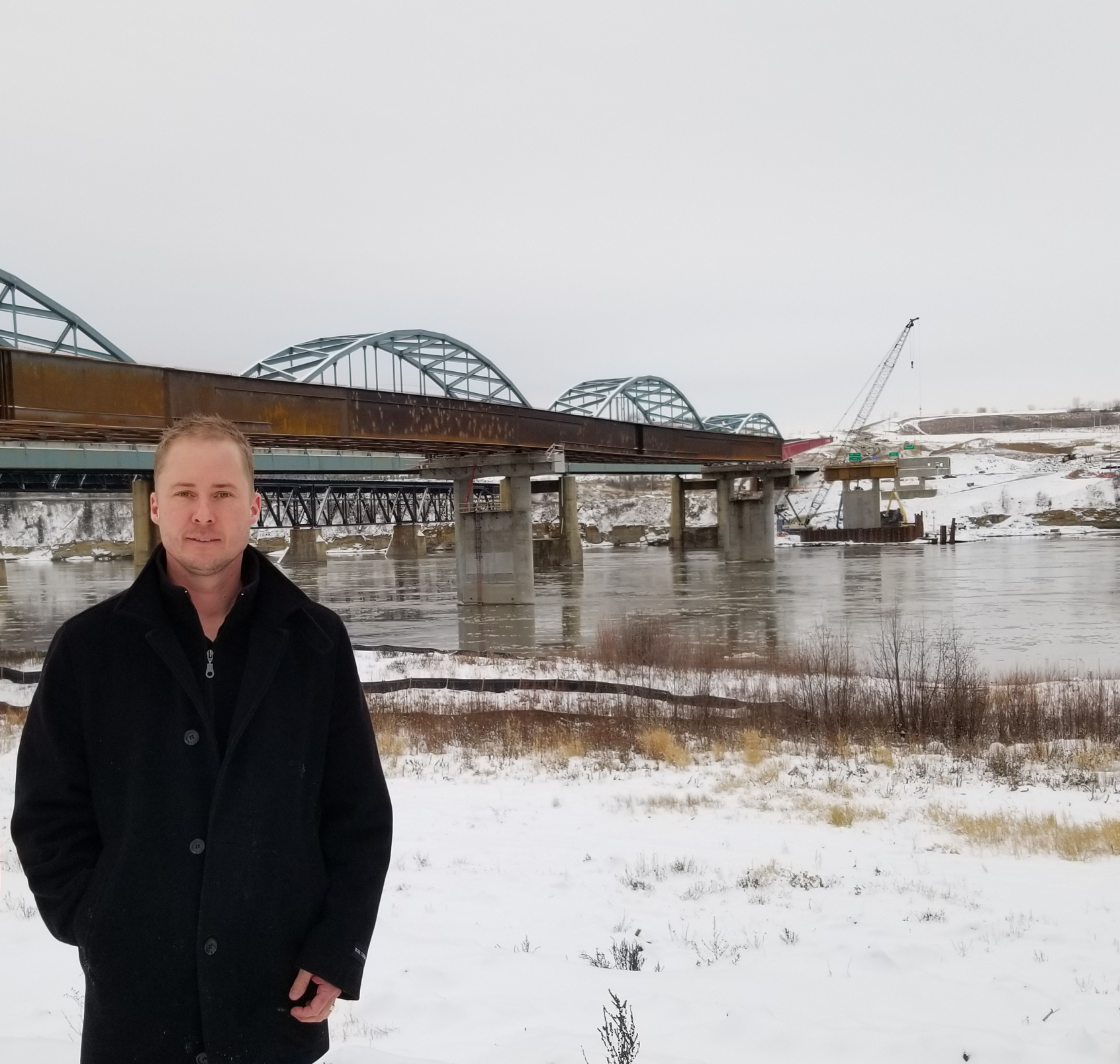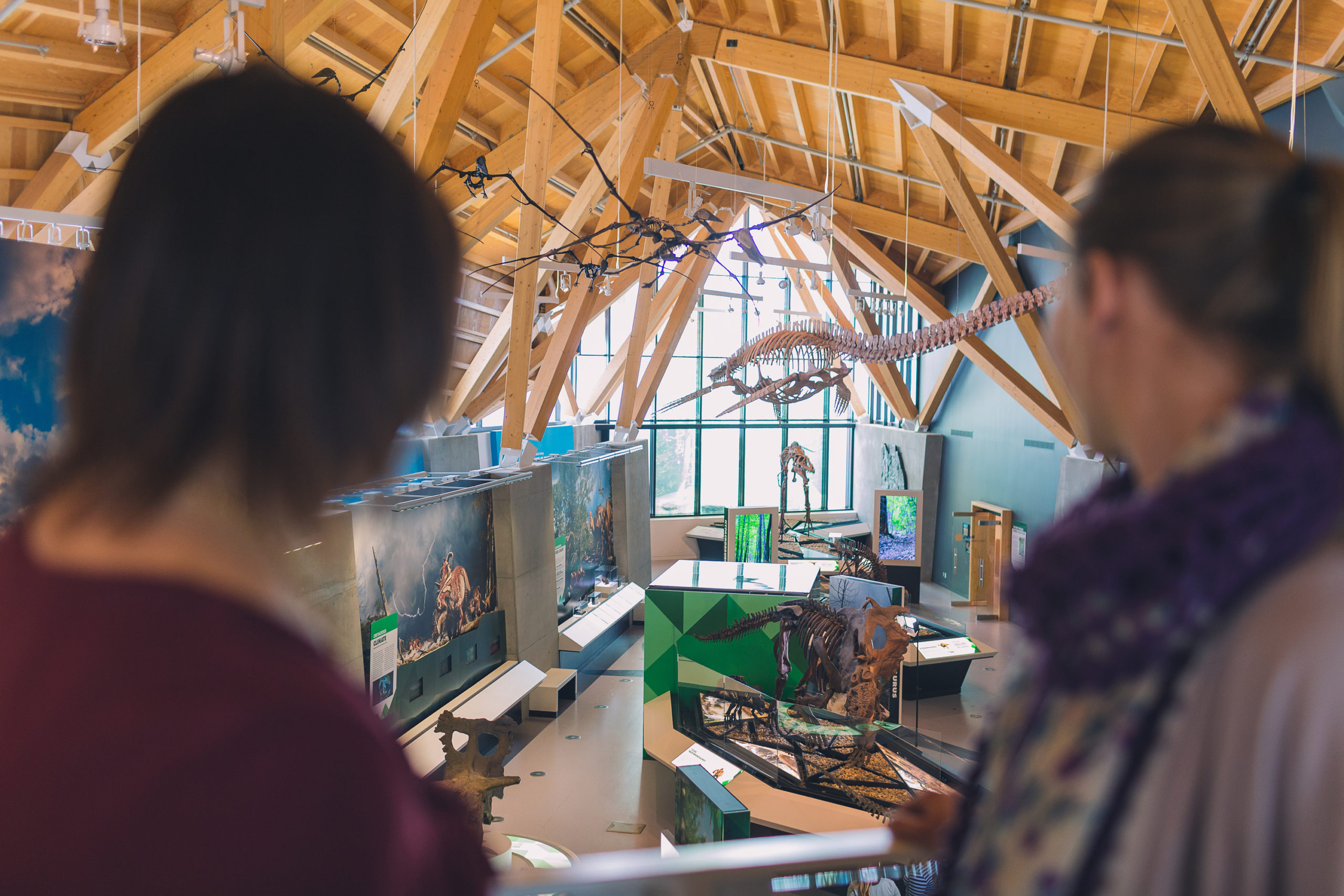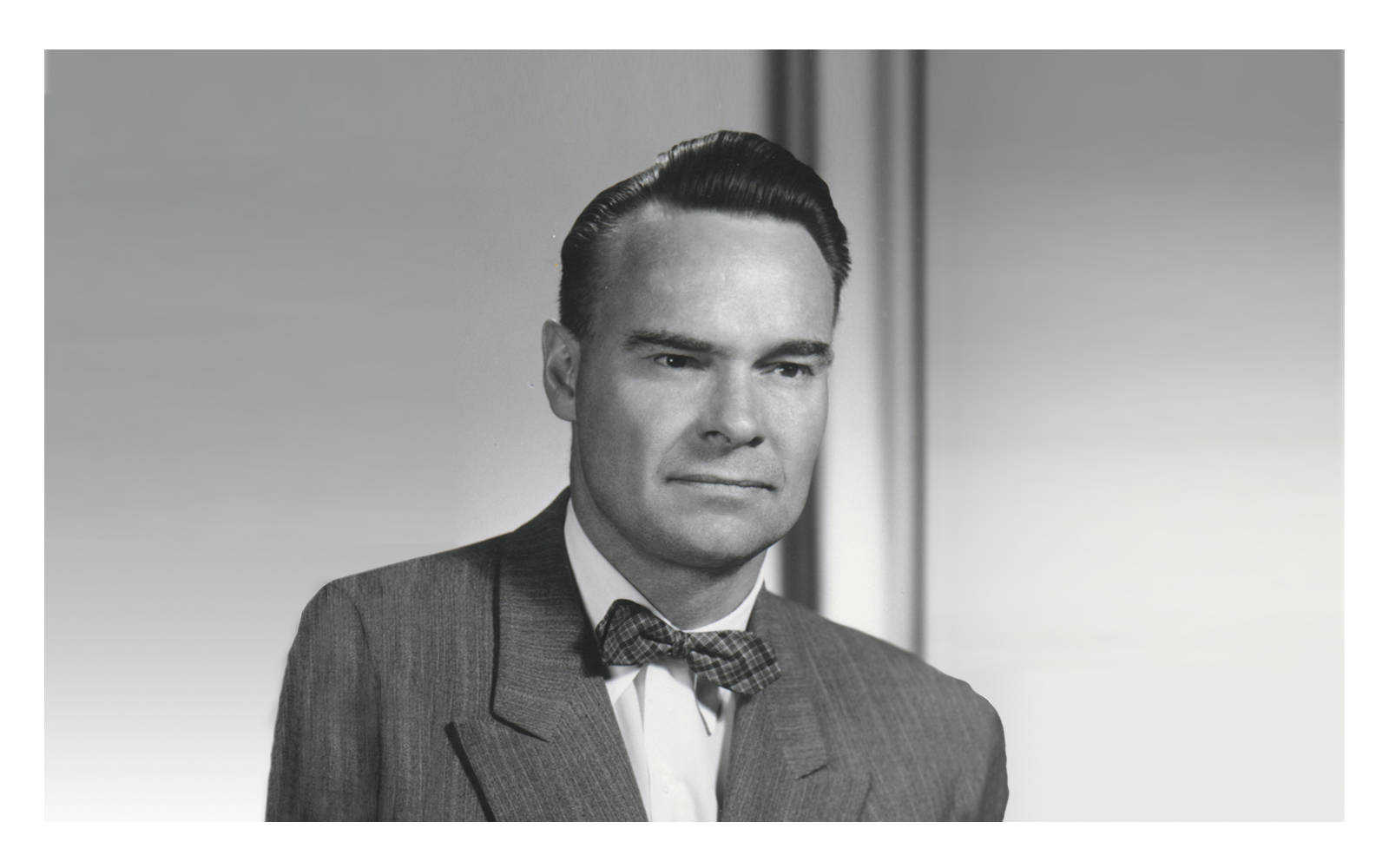Photo courtesy of Ryan Konowalyk, P.Eng.
Bridging the Mighty Peace
Excitement filled the air on July 31, 1968, as hundreds gathered to mark the grand opening of the new Peace River Bridge. No longer would motorists have to wait for trains to pass so they could cross the river on the adjacent railway bridge.
“Townspeople, local officials, engineers, and builders. It was a time for tribute and praise, satisfaction of achievement, it was a time for celebration…From the drawing board to reality. Countless computerized calculations, hundreds of memos, scores of invoices. All aimed at one end result: to bridge the Peace River.”
These words from the narrator of a vintage provincial government video captured the construction of the bridge from its start in 1965 to its completion three years later.
Engineers with the province’s bridge branch had been tasked with planning and designing the bridge and substructure. They decided on a steel, tied-arch bridge supported on four piers. Throughout construction, they came up with several innovative solutions to address challenges that arose. “The imagination of the bridge branch engineers resulted in a substantial savings,” says the narrator.
In 2020, Alberta’s professional engineers will once again be celebrating the opening of a new bridge over the mighty Peace. The existing bridge—which now carries about 17,000 vehicles a day—is being twinned.
Ryan Konowalyk, P.Eng., has a front-row view of construction from his office. As regional director for Alberta Transportation’s Peace Region, he helped plan the project and is part of the team ensuring its successful completion.
“It’s a little extra special, having grown up here in Peace River, and now being part of the team putting up the new bridge,” says Konowalyk. “I can’t go to the hockey rink or the grocery store without having chats with people about the bridge progress and what’s going on. It’s a pretty big deal for our community and the surrounding region.”
The existing bridge is the only way for residents to cross the river, which splits the community down the middle. If an accident blocks access, traffic can back up for kilometres, and the closest alternate crossing is 45 minutes away.
“The hospital is on the west side of the river and all the schools and community facilities are on the east side. So the new bridge is really going to improve safety, ease congestion, and help with the movement of goods across the region,” notes Konowalyk.
Ryan Konowalyk, P.Eng. at the Peace River bridge construction site. In the background is the old train bridge (black steel), the arches from the original highway bridge, and the new bridge as it looked in mid-November 2019.
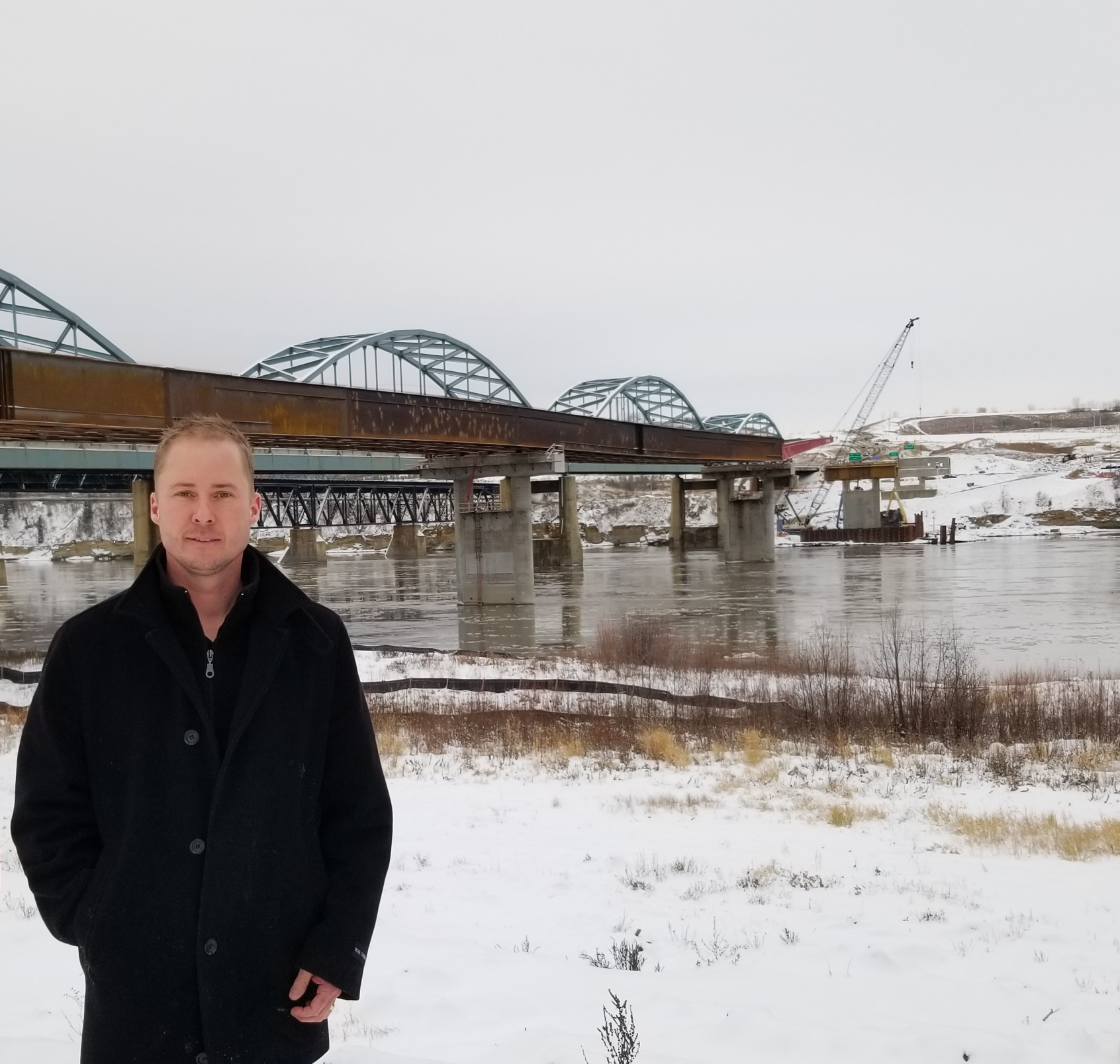
Photo courtesy of Ryan Konowalyk, P.Eng.
Critical Connectors
From the bold and beautiful to the simple and humble, bridges are vital links in Alberta’s transportation network. They get us where we need to go—easier, faster, safer.
Over the past 100 years and more, bridges have helped Alberta communities grow and thrive, especially those in the province’s north.
Take Fort McMurray.
When Grant MacEwan Bridge opened in 1965, it was the community’s first structure spanning the Athabasca River. Before it went up, the only way to cross the river was via an ice bridge in the winter or by boat in the summer.
Not only did the new bridge support development of the region’s landmark Great Canadian Oil Sands project, but it improved access to Fort McMurray—and its community services—for everyone living north of the river.
Nearly 50 years later, Grant MacEwan Bridge was rehabilitated and its iconic trusses demolished, but the original piers remain. They were shortened, and now they accommodate a new bridge deck that connects motorists directly to Fort McMurray’s downtown.
Another important connector for northern Alberta is the Dunvegan Suspension Bridge. Built in 1960, it spans 743 metres across the Peace River near Fairview. It’s the only vehicle suspension bridge in Alberta and was among the first in Canada.
Ralph McManus, P.Eng., the head engineer on the project, spent his career building bridges, including the James Macdonald and Groat Road bridges in Edmonton. But for him, the Dunvegan Suspension Bridge was “the prize,” he told a reporter on the bridge’s 50th anniversary: the greatest bridge he ever built.
The region’s citizens love it too, describing it as an important lifeline. Previously, the only way for travellers to cross the water was to catch a ferry that wasn’t always reliable.
“When these bridges were built, they provided opportunities for people and for industry—agriculture, forestry, oil and gas,” notes Konowalyk. “They were key to opening up the north, and they’ll continue to be important connectors for many years to come.”
By the Numbers
A few fun facts about the new Peace River Bridge construction.
- cubic metres of earth moved: 1,018,570
- kilograms of reinforcing steel placed: 2,229,135
- cubic metres of poured concrete (excluding pre-case concrete): 18,000
- kilometres of driven steel: 10
- kilometres of wick drains: 97
Built in 1965, Grant MacEwan Bridge was the first structure to span the Athabasca River in Fort McMurray. When the bridge was rehabilitated in 2013, everything was demolished except the piers, which were shortened and reused to support a new deck. In conjunction with the rehabilitation of Grant MacEwan Bridge, the Athabasca River Bridge was built in 2011. Built to handle super loads travelling through Fort McMurray to the oil sands, it has the largest bridge deck in Alberta and can carry 12 times the standard weight.
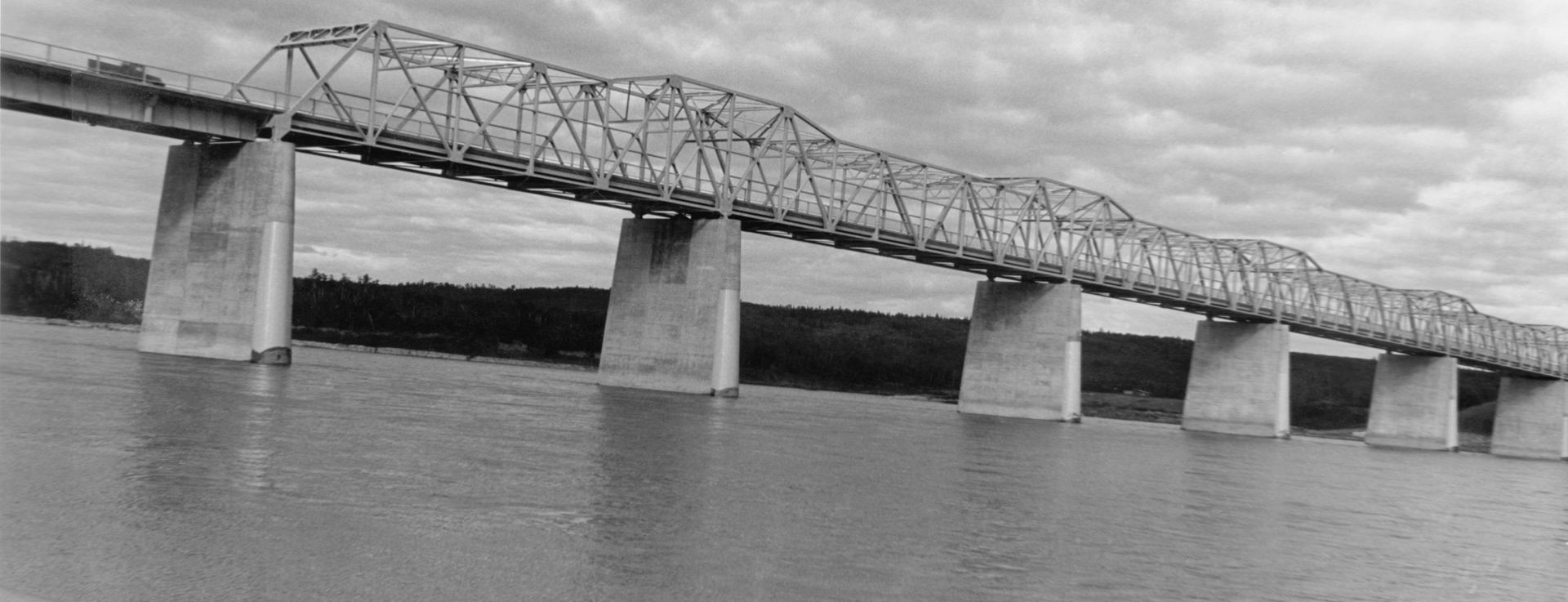
Glenbow Archives PA-3672-9
Bridging the Peace follows the three-year construction of the Peace River Bridge culminating with its celebrated opening in 1968.
Demolition of the original Grant MacEwan Bridge.
Grand opening of new Grant MacEwan Bridge.
